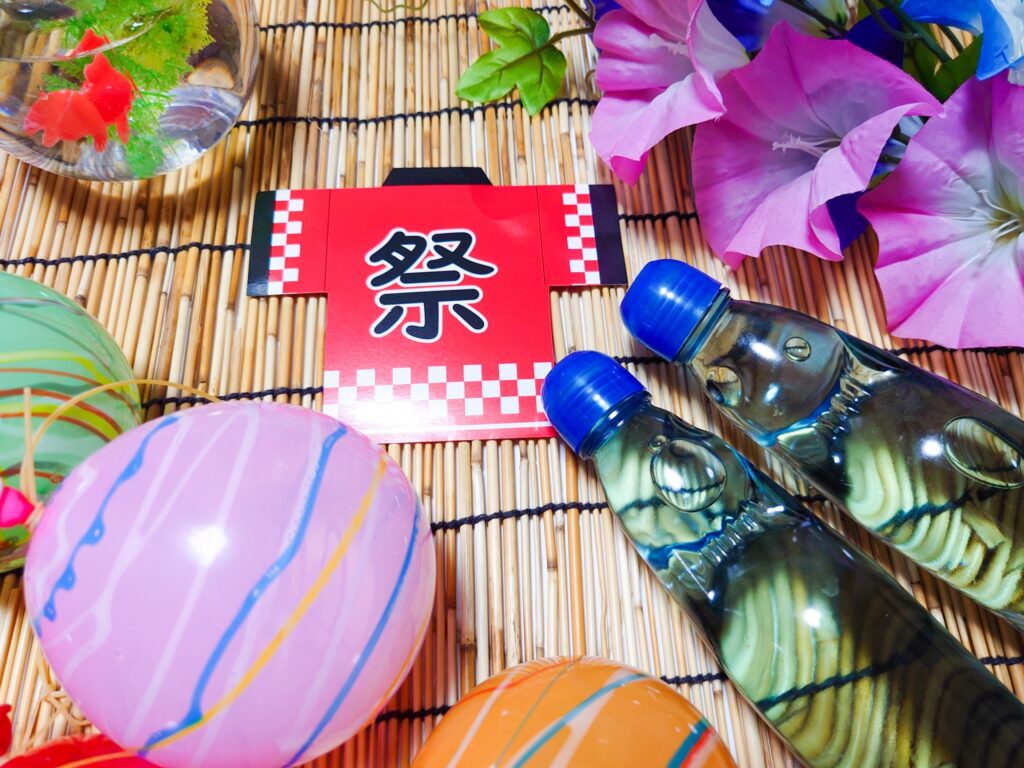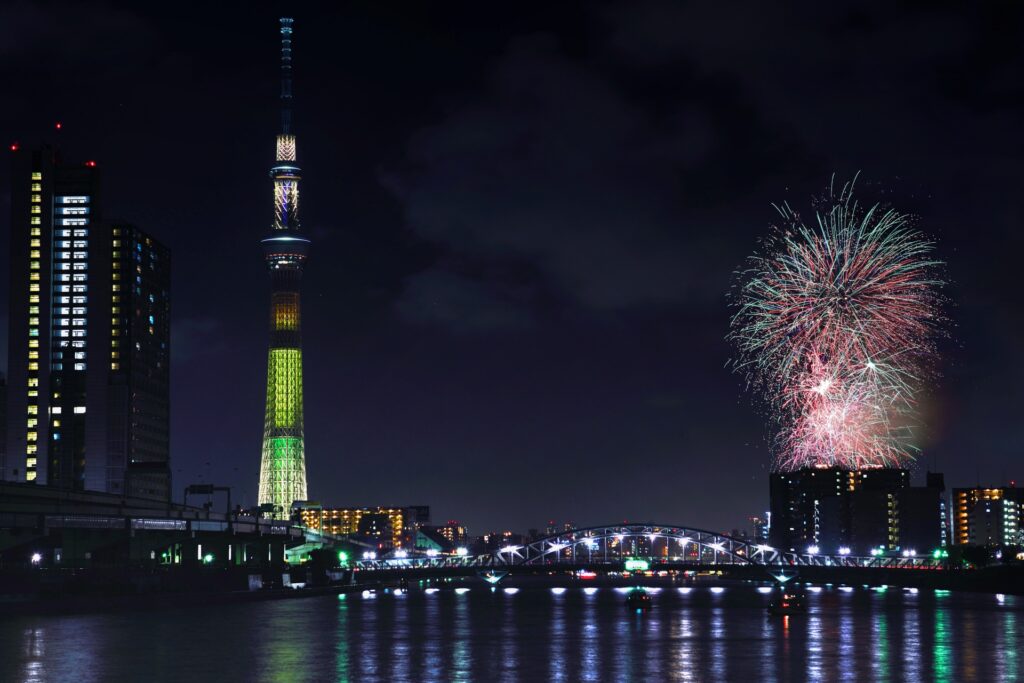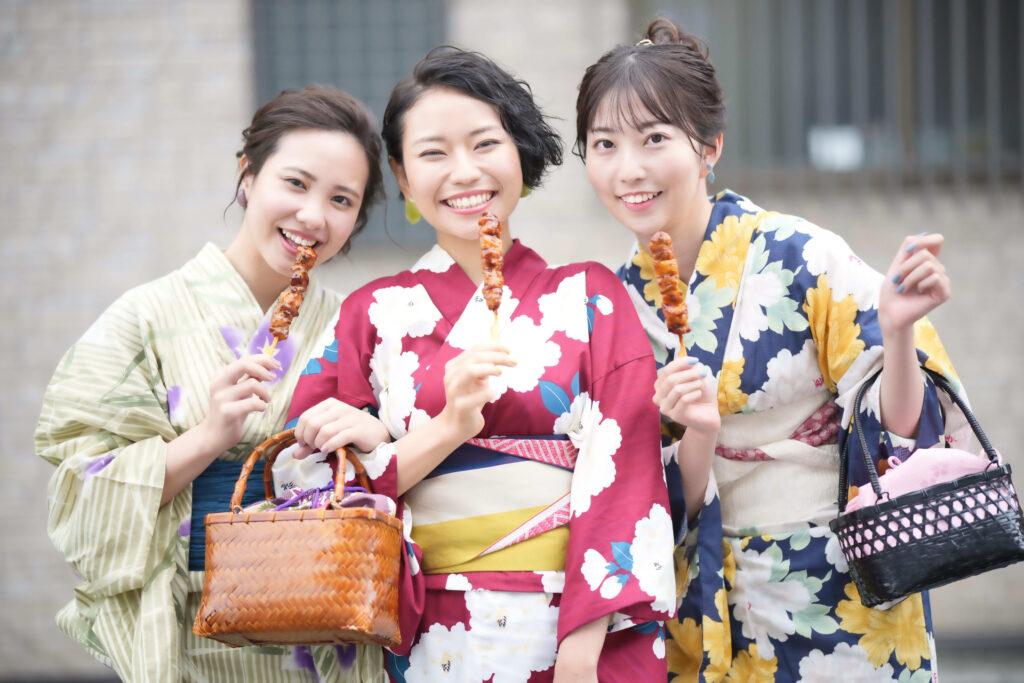
When summer rolls around in Japan, there is one thing that brings everyone out into the streets in yukata and sandals: matsuri, or summer festivals. From the sounds of taiko drums echoing through the night to the sparkle of fireworks lighting up the sky, Japanese summer is a magical mix of tradition, community, and celebration.⁹
While countries like Spain, Italy, or Greece are known for their lively summer festivals with music, dancing, and food, Japanese matsuri offer a uniquely atmospheric experience with centuries-old rituals, traditional street food, and stunning visuals.
👘 The Origins of Japanese Summer Festivals
Japanese summer festivals often trace their roots to Shinto or Buddhist traditions. Many began as seasonal purification rites or agricultural prayers. For example, Obon, one of the biggest summer events, is a time to welcome ancestral spirits with lanterns, dances (Bon Odori), and offerings.
Others, like Gion Matsuri in Kyoto (dating back to 869 AD), were started to appease the gods during plagues. Similarly, Nebuta Matsuri in Aomori originated as a ritual to drive away sleepiness during the busy farming season.
These festivals evolved over centuries but retain their spiritual and communal essence.
🏮 Local Festivals with Unique Charm
While major festivals draw crowds, Japan’s smaller regional matsuri are full of character:
- Hokkaido’s “Ichirinzuke” (One Candle Festival): Children visit neighborhood homes with lanterns to receive a single candle, a custom rooted in ancestral remembrance and neighborly connection.
- Tokushima’s Awa Odori: A vibrant dance festival with rhythmic chants and unique movements.
- Gujo Odori (Gifu): One of the longest dance festivals, where locals and visitors dance through the night.
- Tenjin Matsuri (Osaka): A river-based festival with boats carrying lanterns and performers.
These regional festivals showcase local identity, much like how village festivals in Southern Italy or rural Greece reflect local customs.
🎆 A Brief History of Japanese Fireworks
Fireworks, or hanabi, were introduced to Japan from China in the 16th century. Initially used for religious and ceremonial purposes, hanabi evolved into a summer pastime by the Edo period (1603–1868). The famous Sumidagawa Fireworks Festival began in 1733 as a memorial and a way to lift the people’s spirits after a famine and epidemic.
Over time, hanabi became an art form. Firework makers compete for precision, beauty, and complexity, designing each explosion like a flower or symbol.
🌍 Fireworks with a Japanese Soul
Unlike the explosive celebrations of Las Fallas in Spain or fireworks over the Amalfi Coast in Italy, Japanese hanabi displays are often viewed in quiet awe. People sit on picnic mats by rivers, dressed in yukata, watching in near silence. It’s an experience that combines beauty, transience, and nostalgia.
Some of the biggest shows include:
- Sumidagawa Fireworks Festival (Tokyo)
- Nagaoka Fireworks Festival (Niigata)
- Omagari Fireworks Competition (Akita)
🎇 Changing Times: How Society is Shaping Matsuri and Hanabi
In recent years, modern life has changed how summer festivals and fireworks are held in Japan:
- Safety and Security: After incidents involving overcrowding or accidents, many festivals now implement stricter crowd control and security checks. Police and volunteers are highly visible.
- Noise Complaints: As Japan’s population ages and urban noise sensitivity increases, some festivals have shortened fireworks shows or adjusted timing.
- Lifestyle Shifts: With more people working non-traditional hours or living alone in cities, matsuri attendance patterns have shifted. Many now watch livestreams instead of attending in person.
- Sustainability and Waste: There is growing awareness about waste from food stalls and plastic fans. Some festivals now encourage eco-friendly packaging or reusable containers.
Despite these changes, the spirit of matsuri and hanabi lives on—adapting with the times while preserving their deep cultural roots.
👘 Dress the Part: Yukata Style
Wearing a yukata is a must if you want the full experience. These lightweight cotton robes come in vibrant colors and floral patterns, and are easy to wear compared to the formal kimono. Women often complete the look with a paper fan, a simple updo, and geta (wooden sandals). For men, dark colors and straight lines offer a cool, traditional vibe.
Much like Italians dress up for Ferragosto or Greeks for island weddings, wearing a yukata is about honoring the moment and being part of something festive.
🧵 Evolving Yukata Fashion
Over the years, yukata style has adapted to reflect changing times:
- Modern Patterns & Colors: While traditional floral and geometric prints remain popular, modern designs now include pop culture motifs, neon colors, and even anime collaborations.
- Mix & Match Accessories: Younger generations often add lace belts, western-style bags, or colorful hairpins to personalize their yukata look.
- Unisex & Gender-Free Options: More brands now offer relaxed silhouettes that go beyond gender norms, making yukata accessible and stylish for all.
- Rental Services: Yukata rental shops in cities like Kyoto or Tokyo make it easy for tourists and locals alike to enjoy the tradition without owning one.
This blend of old and new keeps the yukata experience alive—just like traditional garments worn at European village festivals, but with a distinctly Japanese twist of seasonal beauty and self-expression.
🍢 What to Eat at a Matsuri
The food at summer festivals is half the reason to go:
- Takoyaki (octopus balls)
- Okonomiyaki (savory pancake)
- Kakigori (shaved ice with syrup)
- Candied apples, grilled corn, and more
It’s a street food paradise, similar to what you’d find at a Greek panigiri or an Italian sagra. Everything is hot, fresh, and made for walking.
🏮 The Origins of Yatai: Japan’s Festival Food Stalls
The tradition of yatai, or mobile food stalls, began during the Edo period (1603–1868). Originally, they served simple meals like soba noodles or oden to workers and travelers. Over time, these stalls evolved into a beloved part of festival culture. Today, they are especially active during matsuri, offering snacks that are as much about nostalgia as they are about flavor.
Some popular matsuri treats include:
- Ikayaki – grilled squid on a stick, brushed with savory soy sauce
- Choco Banana – bananas dipped in colorful chocolate and decorated with sprinkles
- Jaga Bata – boiled or grilled potatoes slathered with butter and salt
- Baby Castella – bite-sized sponge cakes, often served warm
- Ayuyaki – sweetfish grilled whole, especially popular at riverside festivals
Much like Italy’s street vendors at village fairs, these yatai offer a social and sensory experience. Kids gather to try their luck at ring toss or catch goldfish, while families enjoy strolling and sampling new flavors under paper lanterns.
While the festive energy remains, some cities now regulate yatai more strictly to ensure sanitation and safety. Others promote local ingredients or environmentally friendly packaging to modernize these age-old traditions.
Whether you’re dancing under fireworks in Tokyo or sharing ghost stories on a hot night in Athens, summer is a time when tradition and emotion come alive. Japan’s way of celebrating the season may be unique, but it’s rooted in a human desire we all share: to feel connected, excited, and a little enchanted.
If you love cultural festivals, atmospheric storytelling, or simply discovering new ways people experience the seasons, Japanese summer has something to offer you.
:🎁 Looking for authentic omatsuri goods to celebrate summer wherever you are? We offer a personalized purchasing service—whether it’s lanterns, yukata, festival decorations, or unique gifts, we can help you find and ship them directly from Japan to your door.
We are happy to hear from you!! Please feel free to reach out via the Contact Form, or by Messenger or email ([email protected]), if you would like to know about this summer’s firework events or local festivals in Japan.


